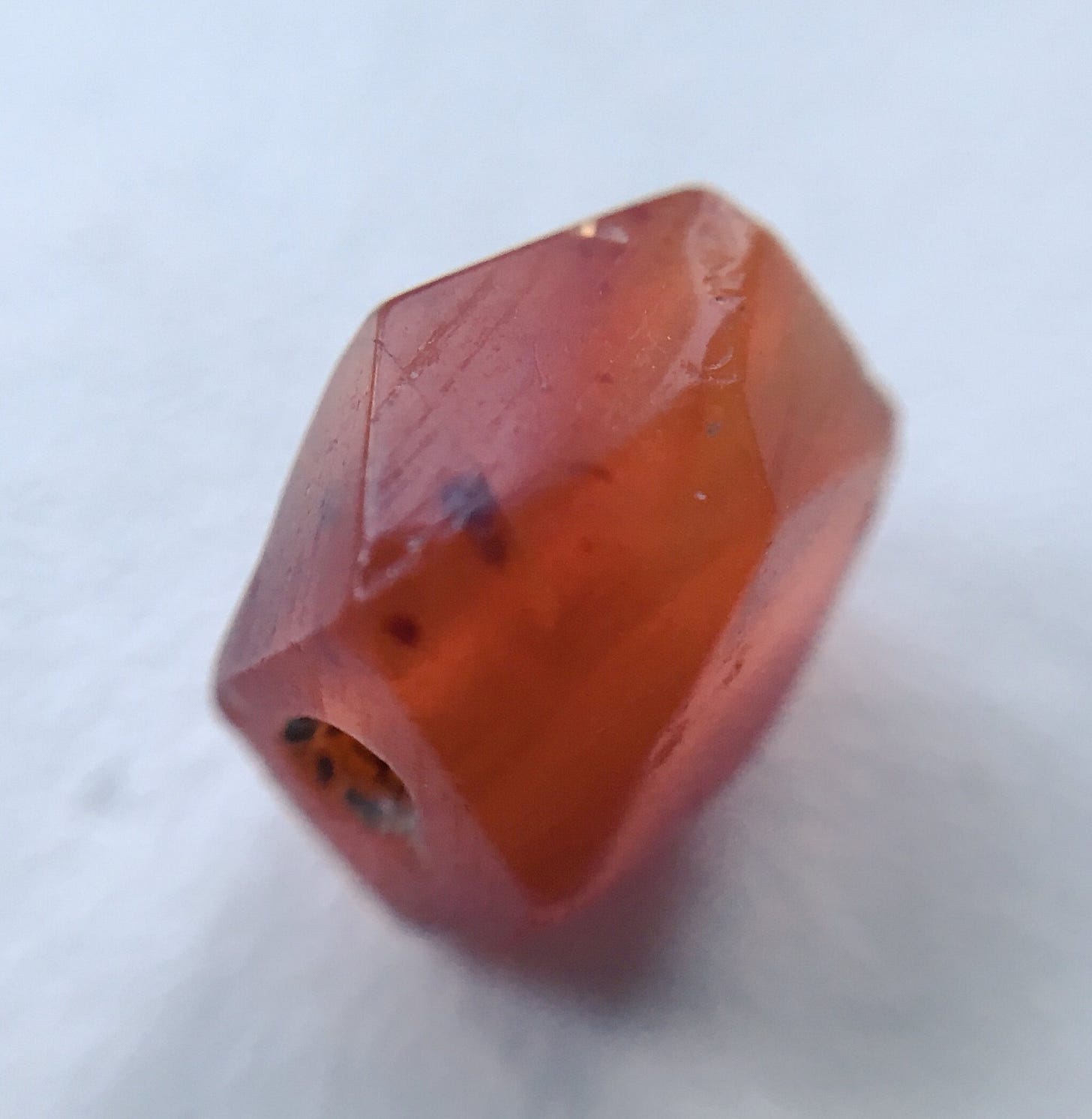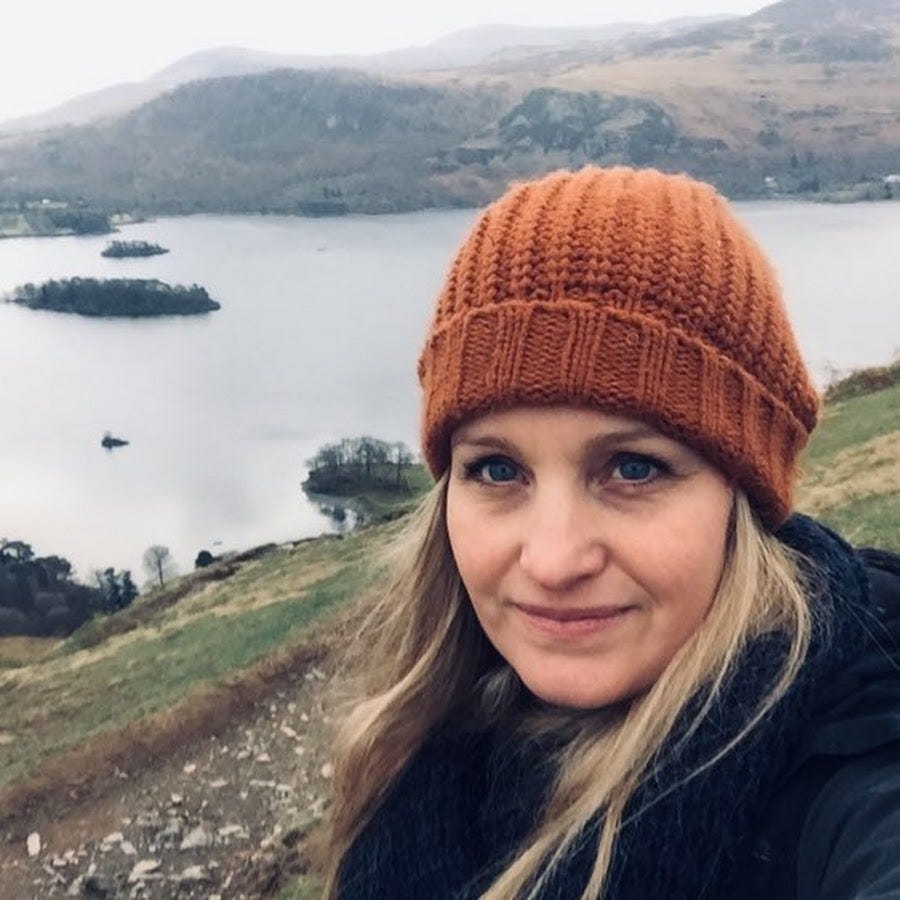It’s Saturday, when I dig through my archives for a book that deserves more attention. Today I’m casting light upon River Kings, by Cat Jarman. Published by Collins in 2021, it’s an enthralling story of how a single carnelian bead that originated in Gujerat ended up buried in a Derbyshire churchyard. This beautifully constructed book combines archaeology, DNA testing, history, travel writing and forensic logic into a compelling account of restless humans unable to stay put.
In the beginning, there was a small orange bead. It seemed at first unremarkable – a trinket easily mistaken for something plastic from Accessorize. Cat Jarman found it in a Tupperware box containing items unearthed in 1982 during an archaeological dig at Repton. Thirty-five years later, Jarman was cataloguing the stuff -- more than 9,000 objects spanned 1,300 years. Here was a Roman enamel broach, there a piece of mediaeval glass. A Victorian bone toothbrush lay next to an Anglo-Saxon comb. ‘I felt like a child let loose in a toy shop after hours.’
That bead came from a Viking mass grave containing the remains of 264 people who were almost certainly part of the Viking Great Army that rampaged around Britain starting in the year 865. In 873, they conquered Repton and the Anglo-Saxon kingdom of Mercia. The bead was carnelian, a semi-precious gemstone mined and cut in India. So how did a bead from Gujarat end up in a Derbyshire churchyard?
River Kings is a mystery and an adventure, the tale of a quest that took Jarman from Repton to Scandinavia, across the Baltic Sea, down the Volga and the Don, on to Turkey through the Black Sea, over to Baghdad and finally to India. Because of a tight schedule, I had to devote a weekend to reading this book. Working weekends usually makes me grumpy. On that Sunday, I should have been on the beach walking my dogs, but instead I was on the couch reading this book. As it turned out, it was the nicest weekend I’d had in a long time, held captive by that single orange bead.
In addition to being a wonderful writer, Jarman is a skilled bio-archaeologist. She uses isotope and DNA analysis, along with radiocarbon dating, to reconstruct the narratives behind the random bones found on digs. It’s now possible, by measuring the strontium content in teeth, to determine that one set of bones found in Repton originated in Norway, while another set came from even further away. The Viking Great Army was an amalgam, a composite force that picked up and discarded people along its journey of plunder. Some 20 percent of those found in Repton were female. Were they concubines or camp followers, slaves or perhaps even warriors? Modern science answers so many questions, but then raises so many more.
Grave 511 was special, the resting place of someone important. He’s the so-called Repton warrior, buried with a silver Thor’s hammer around his neck and symbols of majesty scattered nearby. He died violently, an axe slicing downward through his hip and thigh, probably severing his penis in the process. When buried, a boar’s tusk was strategically positioned between his legs. Jarman thinks the tusk ‘may have been … a replacement to ensure that he was complete on arrival in Valhalla, … where a penis would surely be needed.’ That’s intriguing, but, to be honest, we really don’t know.
This is a tale told by objects – lead weights, gaming pieces, iron nails, fragments of silk, a prosthetic penis. A Buddha figure is unearthed near Stockholm, dirham coins in a Derbyshire field. Scandinavian and Arabic coins weigh the same, suggesting a shared currency. Carnelian beads were rare in the first half of the 9th century, but then, suddenly, became common as muck when new trade routes opened. Ninth century snobs sought to separate themselves from the rabble through conspicuous adornment – the chic of the exotic. Responding to demand, Scandinavian counterfeiters made rings adorned with squiggly writing that meant nothing, but looked Sufic.
What made the Vikings roam? We’d like to think that a spirit of adventure drove them, but it was probably something more prosaic – maybe the pressures of population growth combined with the vagaries of farming on poor soil. They went where rivers would take them; travel by boat was so much easier than by land. They were a big people – in size and drama. While resting on the banks of the River Trent, Jarman tries ‘to imagine what it must have been like if you lived along this river, becoming aware of an approaching fleet of Viking ships sailing downstream towards you: bow-shaped hulls, perhaps elaborately carved heads at the stern.’ Here come the River Kings.
When we consider the Vikings, we think of their movements westward – to Britain, Iceland and eventually America. The more significant movement, however, was eastward. More objects of Scandinavian origin have been found in the East than in the West. They travelled across present-day Russia via the Volga and the Dneiper. When rivers petered out, they transported their vessels overland, sometimes disassembling them like flat pack furniture from Ikea. They eventually tapped into the Silk Road, a conduit of commerce and ideas that had existed for centuries.
Much can be learned from graffiti scratched into the walls and pillars of the Hagia Sophia in Istanbul. Vikings were, basically, lads -- the kind who note their presence through random effacement. On one wall, some Runic script reads ‘Halfdan was here’. Elsewhere, there’s a nice little line drawing of a Viking ship. Leaving Istanbul, Jarman traces the trail to Baghdad, where it finally peters out. In Baghdad markets Vikings probably bought silk, spices and those carnelian beads. Or perhaps we haven’t yet found evidence that they travelled further.
River Kings is like a classical symphony, perfectly composed and exquisitely performed. Tiny trills of detail give way to pounding drums of drama. Fur-clad Volga boatmen carry us relentlessly toward the exotic. Along the way, Jarman takes a sledgehammer to fantasies of ethnic purity. In Gotland, an island in the Baltic Sea that was like a 9th century Felixstowe, less than fifty percent of human remains unearthed are local. Expeditions became, by chance and circumstance, ‘a polyethnic melting pot of groups’. And when people mix, they often, as we know, swap sickness. A skeleton found in Oxford shows signs of smallpox; DNA analysis then reveals a half-brother buried in Denmark with similar symptoms. The chain of contagion probably originated somewhere along the Silk Road.
We end as we began, with a bead. Jarman eventually finds herself in Gujarat, where she encounters a man making carnelian beads identical to that one in the Tupperware box. While he worships in a nearby mosque, she enjoys the view. ‘It is impossible not to feel moved by the thousands of years of history in these hills and plains; to consider the remarkable distances that those minerals have travelled.’ Yes, we’re moved. Daydreaming, she imagines a young woman making beads 1,200 years ago. ‘She has been told that some of them travel far across the sea, to lands where the sun stops shining … and the rivers turn solid and cold in winter. … But she will never know whose hands and lives this bead will touch.’
But now we know.







